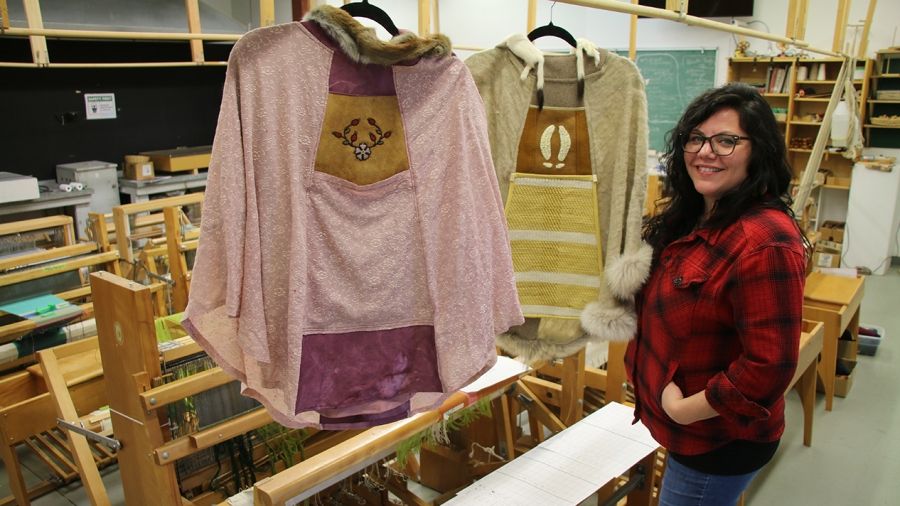
Naomi Bourque carefully scrapes fish scales into a bucket on Selkirk College’s Victoria Street Campus as she thoughtfully transforms the slippery skin into hardy leather. Currently the college’s artist-in-residence, Bourque is in the middle of a project that will see her produce 10 magnificent ponchos that echo her culture and artistic abilities.
Inspired by her Indigenous heritage, Bourque’s work-in-progress is based on medicines from nature such as berries, arnica, birch, fireweed and lichen. Incorporating fur, fish, antler, dyed fabric, claws, ivory and delicate beadwork, the ponchos will be featured in the prestigious Indigenous Fashion Arts Festival that takes place in Toronto at the end of May.
“As much as possible, I want to make every ingredient that I am using so that it is as authentic as possible,” says Bourque. “I am making it my own as it relates to the message that I am sending out through what I am creating.”
Born-and-raised in Yellowknife, Bourque draws much of her inspiration from the beauty of the Mackenzie Delta region. She is of Gwich’in, Métis and Scandinavian descent with grandfathers who were trappers and a mom who is a furrier.
Growing up with a single mom and three siblings, Bourque says money was generally tight, but creativity always blossomed. It is from these humble beginnings and natural ingenuity that Bourque began honing craftsperson skills and artistic expression that continues to be developed as she expands her body of work.
“I grew up making stuff out of scraps, stuff that would have been thrown out,” says the 44-year-old. “So even today, making something beautiful out of nothing or with materials that would have been discarded, I am proud of my resourcefulness.”
Lifelong Learner Lands in the West Kootenay
Starting with selling jewellery at her mom’s small fur and accessories shop in Yellowknife more than two decades ago, Bourque’s use of antler and animal hide in intricate designs was recognized early. Bourque had some of her pieces featured during the Vancouver 2010 Winter Olympics at Northern House, the space operated by Nunavut and Northwest Territories governments as a showcase of Canada’s northern cultures.
Seeking more formal education to spur her part-time jewellery business, she was told about Selkirk College’s Kootenay Studio Arts programs in Nelson. Bourque moved to the West Kootenay in 2011 to begin the Jewellery Program on the Victoria Street Campus, where she spent two years deepening her knowledge, formalizing her designs and sharing in creativity with both instructors and peers.
“I love being a student because I love doing something different every day,” she says. “I feel lucky to learn more and figure out new things.”
Connecting with the creative vibe in Nelson and raising her two young children, Bourque’s hunger for knowledge continued as she grew her jewellery business in a new home. To satisfy her innate curiosity and desire for personal growth, Bourque completed Selkirk College credentials in the Blacksmithing & Metal Arts Program, Hairdressing Program and Professional Cook Training Program. In 2022, she added one more piece to the puzzle with the eight-month Textile Arts Program.
“It’s hands-on from the day you get here, and I love that because it suits my learning style,” she says of her Selkirk College educational journey.
“Theory has its place, but when you are making art then you just have to do it.”
Building Community and Knowledge Never Stops
Bourque’s beautiful incorporation of culture, multi-dimensional skillset and development as an artist have come together in the poncho project that she started while still a student in the Textile Arts Program. Building confidence through the mentorship provided by program instructor Marilyn Lee, she was encouraged to apply for Indigenous Fashion Arts Festival and took a chance.
Now working diligently on the 10-poncho collection that was accepted for the show in the studios of the Victoria Street Campus, she will attend the biennial Indigenous Fashion Arts Festival that attracts thousands of visitors to Toronto. The event showcases fashion through runway shows, an outdoor marketplace, a symposium, hands-on workshops and an art exhibition. An intersection of art and fashion, the festival attracts industry leaders, buyers and national media.
Getting to gather with other artists and craftspeople at the festival is another important educational step for Bourque. Though creativity is influenced by her upbringing, Bourque learned much of her craft independently. With both of her parents scarred from attending residential school and growing up in a time when embracing her Indigenous culture wasn’t encouraged, she continues to build understanding on her own.
“There are so many disconnects in our culture due to what has happened over the last few generations,” she says. “There is a lot of reclamation going on and for the most part I have had to do it myself. A lot of this is finding your own way, but it’s rooted in the culture and brings you closer to the culture.”
Broad appreciation for Indigenous art and design continues to grow in Canada, as does opportunities for those who are creating. While she builds her business and stretches her limits as a working artist, Bourque hopes that her determined pathway and approach to learning will assist others in their own journeys.
“With this work, I feel like I’m speaking to younger Indigenous designers,” she says. “It’s a contemporary take using traditional means, so I am hoping other Indigenous artists will incorporate that into their work.”
Bourque will present an artist’s talk at the Nelson Museum & Art Gallery on February 23 from 7 pm to 9 pm. The talk will focus on her approach, technique and story. All are invited to attend.
Learn more about the School of the Arts at Selkirk College.
Sustainable Development Goal (SDG) #4: Ensure inclusive and equitable quality education and promote lifelong learning opportunities for all.
Sustainable Development Goal (SDG) #5: Achieve gender equality and empower all women and girls.




